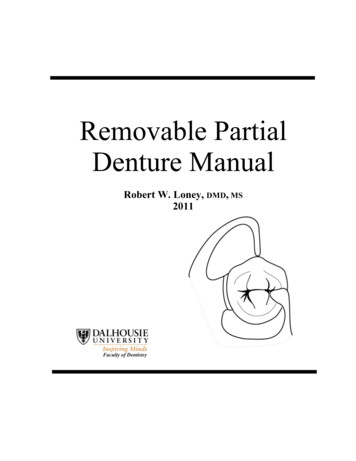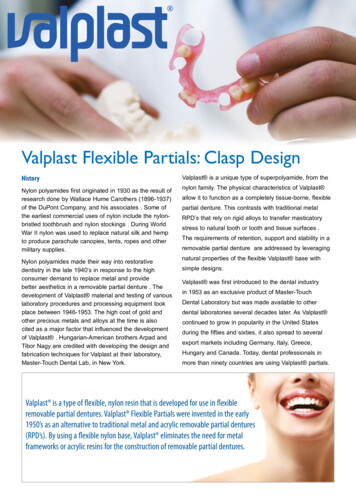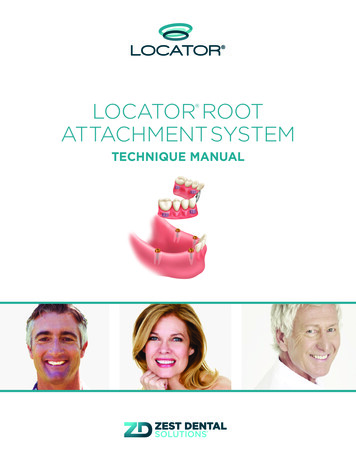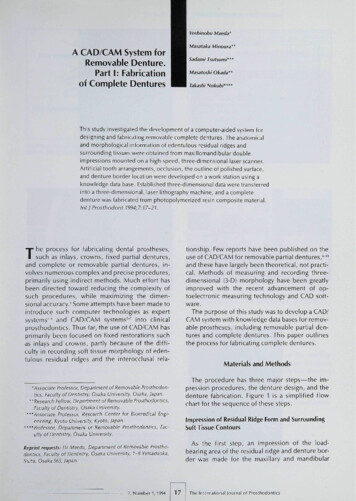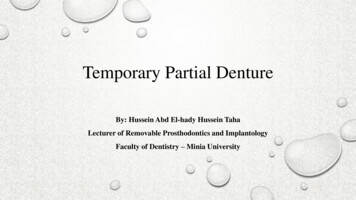
Transcription
REVIEWRemovable partial dentures: The clinical need for innovationStephen D. Campbell, DDS, MMSc,a Lyndon Cooper, DDS, PhD,bHelen Craddock, PhD, MDent Sci, BDS, FDS(Rest Dent), MRD(Pros), MFDS RCS(Edin), MGDS RCS(Eng),DGDP(UK), PGCTLHE(Leeds), FHEA,c T. Paul Hyde, BChD, PhD, DGDP RCS(Eng), MGDS RCS(Eng), FHEA,dBrian Nattress, BChD, PhD, MRD RCS(Edin), FDS RCS(Edin),e Sue H. Pavitt, BSc, PhD,f andDavid W. Seymour, BChD, MFDS RCS(Ed), MSc ClinDent(Rest Dent), FDS(Rest Dent), RCS(Ed)gThe proportion of partiallyABSTRACTdentate adults is increasing,Statement of problem. The number of partially dentate adults is increasing, and many patients willpartly as a result of increasedrequire replacement of missing teeth. Although current treatment options also include fixed partiallife expectancy, a rise in thedentures and implants, removable partial dentures (RPDs) can have advantages and are widely usednumber of elderly individualsin clinical practice. However, a significant need exists to advance materials and fabrication technologies because of the unwanted health consequences associated with current RPDs.within the population, and ashift from total tooth loss/Purpose. The purpose of this review was to assess the current state of and future need for prostotal edentulism toward partialthetics such as RPDs for patients with partial edentulism, highlight areas of weakness, and outlinepossible solutions to issues that affect patient satisfaction and the use of RPDs.edentulism.1-3 The prevalenceof partial edentulism is alreadyMaterial and methods. The data on treatment for partial edentulism were reviewed and sumestimated at greater than 20%marized with a focus on currently available and future RPD designs, materials, means of production,in some regions,4 and theand impact on oral health. Data on patient satisfaction and compliance with RPD treatment werealso reviewed to assess patient-centered care.number of individuals withpartial edentulism could inResults. Design, materials, ease of repair, patient education, and follow-up for RPD treatment allcrease to more than 200had a significant impact on treatment success. Almost 40% of patients no longer use their RPDmillion in the United Stateswithin 5 years because of factors such as sociodemographics, pain, and esthetics. Research onRPD-based treatment for partial edentulism for both disease-oriented and patient-centeredalone in the next 15 years.5 Inoutcomes is lacking.the United States, the averageadult over the age of 20 hasConclusions. Future trials should evaluate new RPD materials and design technologies and includeboth long-term follow-up and health-related and patient-reported outcomes. Advances in materials24.9 remaining teeth, andand digital design/production along with patient education promise to further the application of43.7% of all U.S. adults haveRPDs and improve the quality of life for patients requiring RPDs. (J Prosthet Dent 2017;118:273-280)had a tooth extracted. Individuals over 65 have anDental Health Survey found that “nearly one in fiveaverage of 18.9 remaining teeth, with 43.1% missing 6 oradults wore removable dentures of some descriptionmore teeth.6,7 In the United Kingdom, the 2009 AdultSupported by Solvay Dental 360. This article was prepared according to the International Society for Medical Publication Professionals’ “Good Publication Practice forCommunication Company-Sponsored Medical Research: the GPP3 Guidelines.”aProfessor and Head, Department of Restorative Dentistry, Director, Implant and Innovations Center, Director, Center for Digital Excellence,University of Illinois at Chicago College of Dentistry, Chicago, Ill.bAssociate Dean for Research, Department Head, Oral Biology, University of Illinois at Chicago College of Dentistry, Chicago, Ill.cProfessor Emeritus, University of Leeds, School of Dentistry, Leeds, United Kingdom.dClinical Associate Professor, University of Leeds, School of Dentistry, Leeds, United Kingdom.eHonorary consultant in restorative dentistry, University of Leeds, School of Dentistry, Leeds, United Kingdom.fProfessor of Translational and Applied Health Research, Director of Dental Translational and Clinical Research Unit (DenTCRU), andDivision Head of Applied Health & Clinical Translation, University of Leeds, School of Dentistry, Leeds, United Kingdom.gConsultant, Restorative Dentistry, York Teaching Hospital NHS Foundation Trust, York, United Kingdom.THE JOURNAL OF PROSTHETIC DENTISTRY273
274Clinical ImplicationsThe issues raised can significantly affect the futurequality of removable partial dentures by reducinghealth-related costs and increasing patientsatisfaction and compliance.(partial or complete).”8 This includes the 6% of adultswith complete edentulism as well as the 13% of peoplewho use a combination of dentures and natural teeth.Because the maintenance of oral health has improved,people are losing fewer teeth, resulting in an increasedneed for treatment of partial rather than completeedentulism.2,9 Many patients require replacement ofmissing teeth and associated structures to enhanceappearance, improve masticatory efficiency, prevent unwanted movement of teeth (overeruption/drifting), and/or improve phonetics. Because of the attendant advantages of removable prostheses on teeth and implants, theindications for treatment using removable partial dentures (RPDs) are wide and varied. For example, RPDs canbe indicated to overcome financial limitations, as provisional prostheses, to facilitate hygiene access, and toovercome biomechanical and pragmatic issues associatedwith dental implants.3,10 Long-span edentulous spaces(3 or more missing adjacent teeth) make it difficult toprovide fixed prostheses (for example, retention/resistanceform) resulting in poor prognosis.11 In these situations,tooth-supported RPDs or implants (using fixed orremovable solutions) provide alternative long-term solutions. RPDs are also the best practice therapy for manyclinical scenarios, such as replacing lost hard and softtissues, that result in a need for esthetic support of theorofacial structures, transitional prostheses for the failingdentition, and long edentulous spans.3,10Given the correlation between edentulism (completeor partial) and lower socioeconomic status,12,13 RPDs willlikely remain an important treatment option comparedwith more costly alternatives. Because secondary costsare related to the oral and systemic health consequencesof wearing RPDs,14 a significant need exists to advancethe materials and technologies associated with thesedevices.RPD DESIGNProviding a useful and comfortable RPD requires carefuldiagnosis, planning, and maintenance.3 Previously notedfailure rates of RPDs have led many to conclude thatRPDs are harmful to periodontal tissue and maycontribute to carious lesion formation.15 However, morerecent studies have concluded that while the risk of rootcaries and gingivitis increases, periodontal diseasesTHE JOURNAL OF PROSTHETIC DENTISTRYVolume 118 Issue 3generally occur only in patients with poor hygiene and/ora poorly constructed RPD.3,14 Poor RPD design canexacerbate plaque retention problems, so practitionersshould always consider the partial denture design thatwill best preserve the abutment teeth and edentulousridges.16,17The steps involved in RPD-related therapy includethe evaluation of abutment teeth, abutment tooth position, abutment preparation, adapting the RPD metalframework, relating the edentulous areas to the metalframework, communication with the laboratory, patienteducation for home care and maintenance, and regularprofessional recall.3,10 Because partially dentate patientsmay have lost their teeth because of poor oral hygiene,home maintenance hygiene, caries intervention strategies, and appropriate use of their removable prosthesisare important for minimizing future complications.3,18Accurate custom planning and fabrication of the RPDfor each patient is a critical component of success. Variables such as hard/soft tissue anatomy, occlusal relationships, tooth position, and patient desires foresthetics and comfort should dictate the RPD design thatcan best meet the individual patient’s needs.10Traditional RPD design involves the production ofstone casts, geometric characterization of the tooth andsoft tissues related to the path of insertion, and carefuldesignation of RPD components (major and minor connectors, rests, clasps, and base retention) using a directwaxing method.3,19 Current digital technologies enablethe design of RPD components on 3-dimensional (3D)representations of the patient instead of stone casts byusing geometric analysis tools that create designs ofmicrometer-level accuracy that can be viewed in crosssection. The virtual model can then be used to print waxfor casting metal frameworks or the direct printing ormilling of metal or resin frameworks.CURRENT RPD MATERIALSMetal-based frameworksThe earliest dentures were often fabricated with metal.20Biocompatible metals such as cobalt-chromium or titanium are the current metals of choice for RPD frameworks.20,21 The benefits of metal-based frameworksover acrylic resin are that they are used in thin sectionsand are less bulky, provide high strength and stiffness,conduct heat and cold for a more natural experience,enable designs that minimize the covering of thegingival margins, allow for a stable denture base, undergo repassivation, and are resistant to corrosion.22,23The use of titanium to form RPDs has increased and isoften recommended for large RPDs.22 Although titanium has become a proven biocompatible metal, it cancause inflammatory reactions in an estimated 0.6% ofpatients.24-28Campbell et al
September 2017275Table 1. Advantages and disadvantages of metal and polymer RPDsCharacteristicEstheticsMetal RPDsPolymer (PMMA) RPDsLess desirableMore desirableNonesthetic clasps and frames32,33Potentially translucent or tooth/gingivally colored34Cost-effectivenessMore expensiveLess expensive35Elastic modulusMore desirableMore desirable100-220 GPa36,373-5 GPa (similar to bone)21,23,38Flexural strengthEase of repairEase of formationEase of handlingToxicityOtherMore desirableLess desirablew2500 MPa39w100 MPa40Alloy requires soldering, and repairs are difficult andunpredictable41UnknownLess desirableMore desirableDifficult to form, requiring special equipment41Compatible with existing digital milling and design platforms34,42Less desirableMore desirableDifficult to polish, requires special equipment, difficult to adjust41Easy to polish and adjust34,42More desirableMore desirableSensitization to nickel and possibly cobalt43Generally no cytotoxicity and rare severe reactions/allergicreactions42,44More desirableMore desirableConducts heat/cold, oral galvanism45No metallic taste, good thermal insulator34PMMA, polymethyl methacrylate; RPD, removable partial denture. For toxicity, advantages/disadvantages are patient dependent because of allergies and sensitization reactions.In addition to potential hypersensitivity, other disadvantages of metal RPDs include esthetic issues withmetal display, oral galvanism, adverse tissue reactions,osteolysis of abutment teeth, and biofilm production.21,23,24 A surface layer of protein typically forms onthe metal prosthesis and is a critical component of thebiocompatibility of titanium.23 This initial protein layermay, however, enable colonization of microorganismin the area, allowing the development of a biofilm.Antimicrobials are not effective in destroying biofilm,and so infections can only be treated with physicalremoval or disinfection of the prosthesis. Removableprostheses also act as a reservoir for respiratorypathogens.29Although cobalt-chromium is widely considered thebest material for a denture framework, the physicalproperties of the material itself are not ideal. Keltjenset al30 investigated the fit of retainers after 8 years ofnormal use and found that the majority of metal claspswere distorted and that over time they did not fit theabutment correctly. Another group later investigated thephysical properties of cobalt-chromium clasps andapplied a validated nonlinear finite elemental model thatrevealed the patterns of stress and strain distributions ofdifferent metals during RPD use.31 Through this method,they were able to characterize how cobalt-chromiumdistorts under the stress produced during RPD use andoutline the physical limitations of the material for use inretentive clasps.31Polymer-based frameworksBecause of the drawbacks of metal-based frameworks,the use of metal-free materials, including highperformance polymers such as polyethylene glycol, polymethyl methacrylate, and aryl-ketone polymers, hasCampbell et albeen investigated.23 Some advantages of polymer-basedframeworks over those made of metal are that theyimprove esthetics because of their translucency and color,are more cost-effective, have higher elasticity, arestraightforward to produce, are lightweight, have lowwater sorption and solubility, and are easily repaired andreproduced (Table 1).21,23,32-46The disadvantages of polymer frameworks includelow thermal conductivity, brittleness, less mechanicalstrength than metal (more problematic for mastication), ahigh coefficient of thermal expansion, a relatively lowmodulus of elasticity, faster deterioration than metal, andpossible cytotoxicity because of the leaching of chemicals.35,44,47 In addition, polymer-based frameworks havenot typically included key RPD design features such asrests and indirect and direct retention components. Thishas presented many problems for their broader use.However, a promising polymer-based framework hasrecently been introduced that consists of a modifiedpolyetheretherketone polymer (BioHPP) frame combinedwith acrylic resin denture teeth and a conventional acrylicresin denture base.48 While the BioHPP frame includescritical RPD design features previously lacking inpolymer-based prosthetics, the absence of clinical studiesalong with concerns about how the material may behaveunder fatigue stress during use suggests that it should beused with caution and cannot yet be recommended as analternative to cobalt-chromium.48Current metal- and polymer-based RPDs can beproblematic for patients, and given that the demand forRPDs is increasing, there is a need to develop improvedmaterials for their fabrication (Table 2).35 Given the rapidtransition to digitally designed and fabricated prostheses,the need for new materials that can be developed usingthese techniques is even more important.THE JOURNAL OF PROSTHETIC DENTISTRY
276Volume 118 Issue 3Table 2. Ideal requirements for denture base materials35PropertyRequirementBiologicalShould be nontoxic, nonirritant, and noncarcinogenic.ChemicalShould be insoluble in oral fluids or any other fluids being taken by patient.Should not absorb oral fluids or any other fluids being taken by patient as it causes dimensional changes.Should adhere well to artificial teeth and liners.MechanicalModulus of elasticity should be high. Enables denture base to be rigid against masticatory forces.Resilience should be high to protect underlying soft tissues by absorbing masticatory forces.Should have high elastic limit and proportional limit to prevent permanent deformation when stressed.Should have adequate mechanical strength to resist fracture under repeated masticatory forces.Should be dimensionally stable.Should have adequate abrasion resistance.Specific gravity should be low (especially for maxillary dentures).ThermalShould be good thermal conductor.Coefficient of thermal expansion should match that of artificial teeth.Softening temperature should be more than boiling temperature of water.EstheticShould exhibit sufficient translucency so that it can be made to match appearance of tissues.Should be capable of being tinted or pigmented.OtherShould maintain desirable properties for extended periods after manufacture.Should be inexpensive.Should be easy to manipulate.Should be radiopaque so can be detected if some part of denture is accidentally swallowed.Should be easy to repair.Should be easy to clean.Should have longer shelf life.(Reprinted with permission from the International Journal of Applied Dental Sciences. Alla RK, Swamy R, Vyas R, Konakanchi A. Conventional and contemporary polymers for the fabrication ofdenture prosthesis: part I-overview, composition and properties. Int J Appl Dent Sci 2015;1:82-9.)ORAL HEALTH EVALUATIONFollow-up and future studiesThe health of the periodontium and remaining teeth,particularly abutment teeth, may be at higher risk withthe use of RPDs. Both patient follow-up and futureclinical trials should evaluate these areas.49 RPDs areoften held in place with clasps on abutment teeth thatprovide an area for plaque accumulation, which can bedifficult for patients to clean if they do not regularlyremove the prosthesis.49 Gingival plaque accumulationcan quickly result in caries, root caries, and periodontitis,especially with acrylic resin materials. Because irregularities in the denture can provide microhabitats for plaquebiofilms, the provision of a prosthesis can result in bacteria that may be pathogenic and difficult to treat.Because of mucosal inflammation, dentures can alsocause trauma such as stripping of gingival tissue and painor ulceration; this can be addressed by using correct RPDdesign (Fig. 1).50 During recall appointments, particularattention should be paid to abutment tooth health,proper RPD adaptation, tissue support, occlusal function,hygiene, and caries intervention strategies.Measurement of patient satisfaction and compliancePatient satisfaction with the prosthesis can have a profound impact on the success of treatment becausedissatisfaction with an RPD will likely lead to underuseand subsequent rehabilitation failure. A retrospectiveTHE JOURNAL OF PROSTHETIC DENTISTRYstudy on factors that affect the continued use and patientsatisfaction of RPDs found that 39% of RPDs were nolonger used within 5 years and that patient age, location ofthe edentulous area, number of occluding teeth and rests,and pain all significantly affected patient satisfaction andconsequently compliance.51 Additionally, the estheticappearance of RPDs is particularly valued by patients andshould be addressed to prevent lack of RPD use.47Because dentists tend to focus on the physical function of the teeth while patients are more concerned withthe social implications of RPDs, understanding why patients stop wearing their RPDs is critical.51 Studies withlong-term follow-up on patient satisfaction and compliance and multivariate analyses to control for the influence of multiple possible confounding variables areneeded to further understand the impact of RPD therapy.FUTURE DIRECTIONS AND NEEDSDigital designRPD-associated problems such as poor patient satisfaction and compromised function, esthetics, and oralhealth need to be addressed.9 Improvements in thedesign, fabrication, fit, and esthetics of RPDs are essentialand could be facilitated by the development of newmaterials with adequate strength and flexibility forocclusal rests, indirect retention, and retentive clasp assemblies. RPD frameworks made of novel materials withincreased durability, improved strength, the desiredCampbell et al
September 2017277Figure 1. Removable partial dentureeinduced oral injuries. A, Influence of resin clasp without metal rest on gingival tissue. B, Compression andinflammation of marginal gingiva of abutment tooth due to depression of denture base. C, Nonmetal clasp denture that overloads abutment teeth(intraoral view with denture). D, Terminal abutment tooth (mandibular right first premolar) presenting severe mobility. (Reprinted with permission fromElsevier from Fueki K, Ohkubo C, Yatabe M, Arakawa I, Arita M, Ino S, et al. Clinical application of removable partial dentures using thermoplastic resin.Part II: Material properties and clinical features of non-metal clasp dentures. J Prosthodont Res 2014;58:71-84. Creative Commons License: .)balance between flexibility and rigidity, while improvingthe framework esthetics, would be broadly beneficial.Digital technology and its application to the designand fabrication of a single tooth to a complete-archprosthesis is advancing rapidly. Computer-aided designand computer-aided manufacturing (CAD-CAM) systems are being widely used in the design and fabricationof fixed, implant, and removable prostheses. CAD-CAMtechniques have been investigated as a method ofsurveying 3D-scanned dental casts to create RPDframeworks.10 Dental laboratory technicians and clinicians are using software to design RPD frameworks fromdigital impressions obtained from both intraoral andlaboratory-based digital scanning strategies. The primaryobstacle preventing the broad application of a completeRPD digital workflow has been the difficulty and expenseassociated with producing the metal frameworks.Digital dentistry using CAD-CAM technology, highprecision 3D printers and scanners, and industrialCampbell et alcasting and production techniques can be expected toimprove the fit, esthetics, and functional components ofRPDs while reducing costs and labor, thus increasingefficiency and manufacturing outcomes. However, selective laser melting, milling, and other digital fabricationmethods for metal frameworks are currently restrictive.52Technology such as 3D scanners and denture designsoftware modules promise advancements in RPD production with digitally designed RPDs that can be printedin wax and cast/fabricated conventionally.10 Openarchitecture scanners combined with design softwarecan allow for a precise, digitally designed, machineproduced removable prosthesis that is tailor-made toeach individual patient’s needs.Digital solutions allow the application of advancedmaterials that would otherwise not be used for RPDfabrication. Polymers would be of special interest becauseof their ease of milling/fabrication and desirable properties. The ability to design and produce the RPD digitallyTHE JOURNAL OF PROSTHETIC DENTISTRY
278Volume 118 Issue 3Figure 2. A, Computer-generated image of digitally designed RPD framework, possible with Asahi Kasei Plastics (AKP) resin. B, Computer technologycombined with new polymers provide more precise fitting of denture framework. C, Mandibular RPD using AKP resin as framework (digitallyfabricated). D, Overall fit of RPD on physical model. RPD, removable partial denture.opens up the entire range of biomedical polymers for thecustom patient application that dentistry dictates (Fig. 2).The potential for design control, manufacturing flexibility,and repeatable precision, coupled with the application ofadvanced materials, promises significant advances inRPD-based therapies.Improvements in materials for RPDsThe advent of new polymers with increased biocompatibility, durability, and elasticity and that are moreesthetically pleasing and cost-effective offers significantadvances for RPD-based prosthetics. Various investigations have focused on the development of newpolymers by modifying existing materials with the addition of fillers such as glass, silica, borosilica, and fusedquartz.44 Additionally, a range of alternative binders andprocessing techniques are being examined to develop adental polymer better suited to clinical application.Polymers are well suited to fabrication in the new digitalworkflow, and establishing polymer-based materials andfabrication strategies that will allow for the incorporationof key design features such as rests and indirect andTHE JOURNAL OF PROSTHETIC DENTISTRYdirect retention components will significantly expandtheir applications.The mechanical and physical properties of recentlydeveloped polymers, such as the aryl-ketone polymers,are similar to those of bone and dentin.38 This can allowfor the production of RPDs that are less intrusive whileremaining stable and comfortable. In addition, many ofthese polymers are heat resistant and can offer autoclavedisinfection of the prostheses. However, more research isrequired in the application of currently available polymers for RPDs and there is a need for development ofnew materials that meet the key design requirements forRPDs. As the demand for RPDs increases, the prospectsfor developing polymers with improved structure andbiocompatibility for dental applications are promising.An ideal RPD framework polymer should possessadequate mechanical properties for functions such asreciprocation and resistance to impact forces and excessive wear. A polymer-based RPD frame should incorporate key design features such as occlusal rests anddirect retention arms/strategies. In addition, it wouldesthetically match the teeth and mucosal tissues of theCampbell et al
September 2017mouth and provide long-term stability.44 Appropriatepolymers should also be chemically stable (no deterioration or leaching of monomers), biocompatible, andstable at various temperatures, and it should haverheometric properties that allow for elastic deformationand recovery with the application and removal of stress(resistance to permanent deformation).44 Advances inmechanical and esthetic properties of new RPD materialsmay provide the opportunity to reconsider fundamentalpartial denture design principles that, for the past 80years, have been largely based on the properties ofcobalt-chromium. These novel materials offer potentialdesign innovations, including improvements in the distribution of mechanical stress associated with RPDfunction. Advancements in RPD materials such as thesehave the potential to significantly improve patient outcomes such as satisfaction with function and esthetics.ResearchMore research is needed regarding the effects of RPDs onthe oral health of soft tissue and remaining teethcomparing commonly used materials with emergingmaterials for the fabrication of RPDs. Randomized clinical trials (RCTs) are considered the highest-qualitydesign for informing health care interventions and forperforming metaanalyses to answer important clinicalquestions; however, a recent review found that between1986 and 2014, only 86 articles reported on RCTs forremovable prosthodontics, and of those, only 26% reported on non-implant-assisted removable prosthodontics such as RPDs.53 Furthermore, a Cochrane systematicreview on interventions for the partially absent dentitionidentified only 5 trials evaluating RPDs for inclusion.1Three of the trials evaluated different aspects of RPDdesign,54-56 one trial evaluated different materials used inRPDs,57 and another compared different fabricationtechniques.58 It can be concluded that there is a shortageof clinical trial data on RPDs, leading to a lack of evidence. There is no agreed minimum outcome data set toassess the prosthesis and no consensus over whichoutcome measures, including patient-reported outcomes,should be collected.Investigation into the outcomes of interest in previousclinical trials may be helpful in determining gaps in thefield, areas of improvement, and future study design.Over the last 3 decades, among the RCTs in removabledental prosthetics, the most frequent primary outcomeswere based on biology, physiology, and patient satisfaction.53 Disease-oriented measures of mastication havealso been reported as both primary and secondary outcomes. Prosthesis survival, rehabilitation success rate,variables associated with denture quality, and maintenance and mechanical complications were othercommonly reported items. Ideally, future research shouldinclude key areas of consideration such as longevity andCampbell et al279survival of the RPD, critical RPD design features andmaterials, functionality of the prosthesis and how it affects the patient, the psychosocial impact of wearingRPDs, including patient satisfaction and quality of life,and the economic impact of treatment with RPDs overboth the short and long term. Because numerous outcomes associated with clinical, dental, and patient factorsinfluence the best treatment options for partial edentulism, more RCTs that evaluate all of the consequentialconcerns are necessary to inform and ultimately advancethe field.CONCLUSIONSIn the coming years, the number of patients with partialedentulism will rise along with the need for costeffective treatments such as RPDs. Complications andtreatment failures may occur with RPDs, and rigorousresearch is needed to examine the strengths andweaknesses of different RPD designs and new techniques and materials. Proper evaluation of the dentitionstate, tooth position, abutment preparation, adaptingstructures within the RPD, patient education, timelyrecall, and maintenance are only a few of the stepsrequired for success. Treatment with RPDs shouldideally result in improvements in overall oral health,patient satisfaction, and compliance.Research and advancements in the application ofdigital technologies and improved materials such asbiocompatible metals and polymers have the potential toresolve many of the issues surrounding RPD use and oralhealth. Digital strategies widen the scope of therapeuticapplications for partial dentures as a result of improveddesign and production control, new materials, andimproved efficiencies that will likely enhance outcomesand improve patient experiences. The need for RPDs isexpected to increase. RPD strategies must continue toevolve and improve to best care for the growing partiallyedentulous population. The combination of improvedmaterials, digital design, research, and education as itrelates to caring for patients with partial edentulismpromises to improve the quality of life for our patients.REFERENCES1. Abt E, Carr AB, Worthington HV. Interventions for replacing missing teeth:partially absent dentition. Cochrane Database Syst Rev 2012;2:CD003814.2. Douglass CW, Watson AJ. Future needs for fixed and removable partialdentures in the United States. J Prosthet Dent 2002;87:9-14.3. Benso B, Kovalik AC, Jorge JH, Campanha NH. Failures in the rehabilitationtreatment with removable partial dentures. Acta Odontol Scand 2013;7
Removable partial dentures: The clinical need for innovation Stephen D. Campbell, DDS, MMSc,a Lyndon Cooper, DDS, . Design, materials, ease of repair, patient education, and follow-up for RPD treatment all . should always consider the partial denture design
